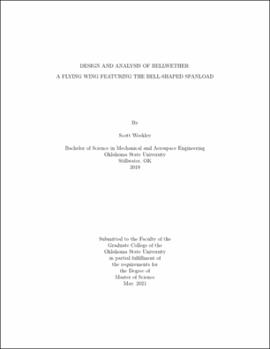| dc.contributor.advisor | Jacob, Jamey D. | |
| dc.contributor.author | Weekley, Scott | |
| dc.date.accessioned | 2021-09-24T13:58:18Z | |
| dc.date.available | 2021-09-24T13:58:18Z | |
| dc.date.issued | 2021-05 | |
| dc.identifier.uri | https://hdl.handle.net/11244/330953 | |
| dc.description.abstract | This body of work details the design and analysis, as well as discussion of requirements for eventual fabrication and flight testing, of a flying-wing aircraft. The design presented is focused primarily on matching the lift distribution to a bell curve and its effect on aerodynamic performance for this aircraft configuration. Various analysis methods of the software-driven design are justification for the wing shape: panel method, vortex lattice method, and computational fluid dynamics. The key phenomenon examined by the analysis methods, and to be measured from the on-board inertial measurement unit, is proverse yaw. The unique wing twist used to match the desired lift distribution encourages a favorable longitudinal force differential by the aileron-deflected wingtips engulfed in upwash flow to induce thrust at the wingtips. This yawing motion as a consequence of roll promotes a naturally coordinated turn without the demand for rudder authority. The observation of proverse yaw coupled with vorticity scenes, resultant from computational fluid dynamics, synchronizes this work with emerging research suggesting the bell spanload is the apt model for avian flight. Additionally, this study parameterizes lift distribution to investigate, through highly-computational methods, the centralization of lift and the aerodynamic effect with the change in shape of the flow field. The inboard movement of the vortex cores with centralized lift is found to be directly proportional to the proverse yaw control power responsible for coordinated flight without an auxillary yaw device. Level and banked-flight analyses are used to weight the tradeoffs between the creation of favorable yaw and the aerodynamic efficiency of the lift distribution in steady operation. The significance of this validation through computational methods may be used to justify reducing the size of a vertical tail on more traditional aircraft configurations or to consider using a bell-shaped lift distribution on flying-wing aircraft for greater efficiency in banked turns. | |
| dc.format | application/pdf | |
| dc.language | en_US | |
| dc.rights | Copyright is held by the author who has granted the Oklahoma State University Library the non-exclusive right to share this material in its institutional repository. Contact Digital Library Services at lib-dls@okstate.edu or 405-744-9161 for the permission policy on the use, reproduction or distribution of this material. | |
| dc.title | Design and analysis of Bellwether: A flying wing featuring the bell-shaped spanload | |
| dc.contributor.committeeMember | Paul, Ryan | |
| dc.contributor.committeeMember | Arena, Andy | |
| osu.filename | Weekley_okstate_0664M_17223.pdf | |
| osu.accesstype | Open Access | |
| dc.type.genre | Thesis | |
| dc.type.material | Text | |
| thesis.degree.discipline | Mechanical and Aerospace Engineering | |
| thesis.degree.grantor | Oklahoma State University | |
